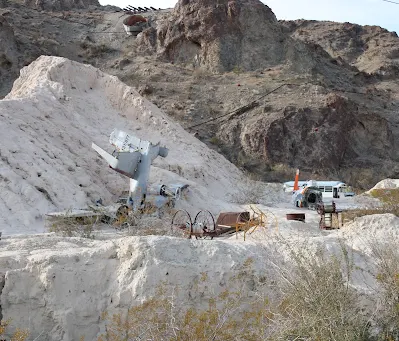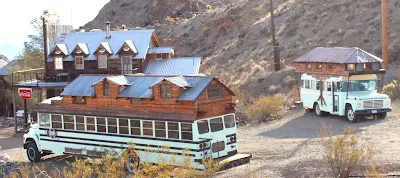.JPG) |
| Old mining cars on display in Ludlow, California |
I spend a lot of time driving along that black ribbon of Interstate 40. Do I enjoy it? Sometimes. And it is the path from here to there I need quite often for expediency. Though, Route 66 is my preferable stretch of road. It’s slower, more scenic, and allows me to just ponder.
Pondering is important. .
No one likes things weighing on my mind. But I do like to think about, or reflect every now and then. To consider things soberly, quietly, or with some good old rock and roll playing in the background. I’d even say I contemplate some things deeply, as if I were a great deep thinker of soul searching meanings, but honestly, I’m often more of a surface kind of guy.
But I do like the term ponder. It rhymes with wander. So, wandering as I do gives me time for pondering.
‘He’s just a wandering and pondering sort of fella.’
So recently, while wandering along Interstate 40 and passing the exit for Ludlow, I began pondering about the history of this small berg fifty-one miles east of Barstow and ninety-two miles west of Needles. Passing it so many times during my eons on this planet, I never gave the history of the town much thought. No offense to those who reside in Ludlow - a lovely group of folks - but when I’d stop in Ludlow, there was a specific reason for said stop: pump some gas, grab a meal, or a big delicious and calorie filled DQ desert, and hit the road again.
The town deserves better.
Time for some research.
I discovered that Ludlow was once a booming town. But, as with many such towns that hugged Route 66 like a belt on a pair of pants after Thanksgiving dinner, a diet was in the near future. And that diet was the completion of Interstate 40.
That darn Interstate 40! But, I digress.
Ludlow was once such a happening place that it once hosted an automobile race in 1914 from Los Angeles to Phoenix along National Trails Highway, later known as Route 66, with the famous race car driver, Barney Oldfield as the main attraction.
It was reported that people as far away as Death Valley, descended on Ludlow to view the Cactus Derby, with the hopes of catching a glance of one of this country’s racing legends.
But there is so much more to Ludlow. And I’m not just writing about the reopening of the DQ there – though, that is pretty big news.
Hmmm, banana splits on a hot summer afternoon. Oops, digressing again.
Turns out that this small community began in the 1870’s. In 1882, the actual town of Ludlow was founded as a water stop for the Atlantic and Pacific Railroad, and named after William Ludlow, a train car repairman who did such a good job repairing things, that clearly, the railroad needed to name a town after him.
The small railway stop started to really build into something grand when gold was discovered in the nearby hills. Where there is gold, there is a boom. And a boom was a-booming.
As miners flocked to the region, entrepreneurs also moved in offering all sorts of distractions for those tired and grubby guys with pockets full of gold to spend on lonely weekends.
One such person was Mother Preston, who built or purchased buildings to convert into a general store, hotel, boarding house, a saloon, café, pool hall, and even a few homes. She was one smart business woman.
According to an article in the San Bernardino County Sentinel, Mother Preston became so wealthy, she sold her holdings to the Murphy Brothers, who already owned the rest of the town, and promptly retired to France.
It is reported that Mother Preston stated, “Ooh, la la!” after the sale of her holdings. A rough translation is – “Wow, is Versailles for sale?”
In 1900, gold was discovered in the Bagdad-Chase Mine, and became the largest gold-producing mine in San Bernardino County. In fact, the mine produced half of all the gold mined in the county.
Ludlow was also utilized as the southern railhead for the Tonopah and Tidewater Railroad, which was owned by the Pacific Coast Borax Company.
Borax, the answer to those nasty stains in clothes. A little here and a little there, and whammy, just like brand new.
“Johnny, your clothes are filthy!”
“Don’t worry, ma,” Johnny replied. “A little Borax, and they are good as store bought.”
“You are a smart young man, Johnny. You may end up writing for a newspaper someday.”
“My dream of dreams, ma.”
Anyway - with all that gold, and the Borax pouring in from Death Valley, Ludlow began to truly prosper.
For the next few decades, the town continued to grow, as new mines were established, trainloads of Borax along with other minerals coming through, and the advent of the automobile, there didn’t seem an end to the expansion of this town in the Mojave Desert.
But by the 1940’s there wasn’t much use for all the rail activity with the ore playing out and other avenues being found for the delivery of the minerals. The railroads became more efficient and water stops no longer played much of a roll in their daily lives.
The love of the American automobile came to the rescue to Ludlow. Vehicles roared by on Route 66, right through the town where visitors could grab a night’s sleep at a motor court, grab a meal at the Ludlow Café, fill up at the gas station, or just relax under the branches of a shady tamarisk tree.
But then in the late 1960’s, Interstate 40 was completed, and even though it was merely inches from Ludlow, travelers didn’t need to stop any longer.
“Can’t we stop? I’m hungry,” a child was heard to whine, through the open window of a passing Chevrolet.
“Can’t stop, we’re on a mission to get east of here,” the father replied. “There’s boating fun to be had on the Colorado River.”
So, the people sped by and Ludlow dwindled in population and importance.
Though, it is still an important stop in my mind. Here I go with pondering again.
History is alive here in this little highway town. Strong and independent people took a shot at life in a very hostile environment - threw the dice and survived.
No, not only survived, but prospered.
Sure, now there isn’t much to the town. Deserted buildings, empty lots, ruined structures, and an old cemetery – but the town truly lives.
There’s a hotel, café, gas station, and the planned re-opening of the revamped DQ attached to a gas station on the north side of Interstate 40.
.JPG) |
| A great place to stop and eat in Ludlow, California |
Most of my sources agree that Ludlow is a ghost town. I say nope, this town is alive, and all the times I’ve stopped there – not one ghost have I seen.
Recently, I stopped at the Ludlow Café and had a great and healthy breakfast (that was for Laureen’s benefit, she worries about me). I pondered on how much grit the early settlers had in settling in such hostile and questionable surroundings. They had it, no matter the obstructions thrown in their path.
And their legacy lives on.
Ludlow might be thought of as a little community, but one with a large part of the history of the Mojave Desert. There is so much to explore in the area, if you have the time.
.JPG) |
And a place to rest your head for the night in Ludlow, California
|
Albert Einstein once wrote; ‘People like us who believe in physics know that the distinction between past, present and future is only a stubbornly persistent illusion. Time, in other words, is an illusion.’
Can’t argue with a guy rumored to have an IQ of ten thousand, but I know that time, in this world is not an illusion.
Watching your children grow up, a person realizes that time is real and it’s precious. Time for us mere humans is finite.
That’s why I travel and look for new things. New doesn’t mean new construction, but things I didn’t know were there. The history of Ludlow is just one more example.

.JPG)
.JPG)
.JPG)








